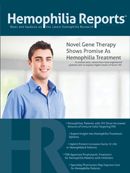Publication
Article
Hemophilia Reports
Expert Insight into Hemophilia Treatment Options
The AJMCtv Peer Exchange video editorial series provides a multi-stakeholder perspective on important issues facing medical professionals in the evolving healthcare landscape. The recent multi-part "Rare Diseases" panel discussion featured several segments that focused on the treatment of hemophilia.
The AJMCtv Peer Exchange video editorial series provides a multi-stakeholder perspective on important issues facing medical professionals in the evolving healthcare landscape. The recent multi-part “Rare Diseases” panel discussion featured several segments that focused on the treatment of hemophilia. Participants included Patrick F. Fogarty, MD, director of the Penn Comprehensive Hemophilia and Thrombosis Program at the University of Pennsylvania; Hugh Fatodu, RPh, MBA, director of pharmacy at Johns Hopkins Healthcare; and Maria Lopes, MD, MS, Chief Medical Officer, CDMI Health.
Highlights include:
A Clinical Overview of Hemophilia
In this segment, the panelists cover a range of clinical topics, noting that hemophilia patients who are not optimally treated may experience bleeding episodes, reduced physical activity, decreased social participation, and long-term hemophilic arthropathy. As a consequence, hemophilia is a serious condition that is tied to substantial clinical and economic burdens, imposes a negative impact on patient quality of life, and therefore must be managed appropriately.
Current Therapeutic Strategies for Hemophilia
The panelists discuss several clinical and financial challenges associated with hemophilia treatment, and conclude that although there have been improvements in the accessibility and delivery of patient care, physicians and allied healthcare professionals who practice at specialty hemophilia treatment centers are still best equipped to implement and follow treatment guidelines, as they are able to provide on-site multidisciplinary, comprehensive care. In an effort to provide the highest quality care to all patients with hemophilia, regardless of geography, strategies such as home care, satellite clinics, and increased patient education have been implemented into contemporary treatment paradigms.
Addressing the Gaps in Care for Hemophilia Patients
During this segment, the panelists discuss the importance of hemophilia treatment centers, address several factors that affect patient care, and stress the importance of new research and data which may help eliminate outstanding clinical challenges. The panelists note that current data reveal that hemophilia treatment centers provide better outcomes for patients and decrease the number of emergency department visits and rates of hospitalization. Unfortunately, not all areas of the United States have ready access to these facilities. There is also a substantial lack of consistency of care between existing hemophilia treatment centers. Thus, transparency in hemophilia care is more important than ever; all variables that affect the consistency of the cost and value of care among these facilities must be addressed.
Treating Mild and Severe Hemophilia
This segment features extensive discussion of the treatment goals for hemophilia, based on disease severity. Topics covered include primary and secondary prophylaxis for the treatment of mild and severe hemophilia, recommended target trough levels and dosage requirements based on disease severity, and the impact of recently developed agents on patients’ quality of life.
Long-acting Agents and Treatment Considerations
Here, the panelists consider several important clinical and economic issues in hemophilia treatment. For example, they discuss how new factor VIII and factor IX protein products improve treatment for hemophilia patients and explain why ensuring access to these medications is important. They also note that, despite their clinical benefits, the use of longer-acting agents can lead to more product waste, and suggest that specialty pharmacies can help improve with inventory management. The clinicians also talk about the importance of developing a fair balance plan in hemophilia treatment, explaining that the goal of practicing fair balance should be to minimize waste by recommending lower dosage requirements, while reducing the frequency of bleeding episodes.
To access the complete “Rare Disease” episode of the AJMCtv Peer Exchange video editorial series, visit the AJMC website.



